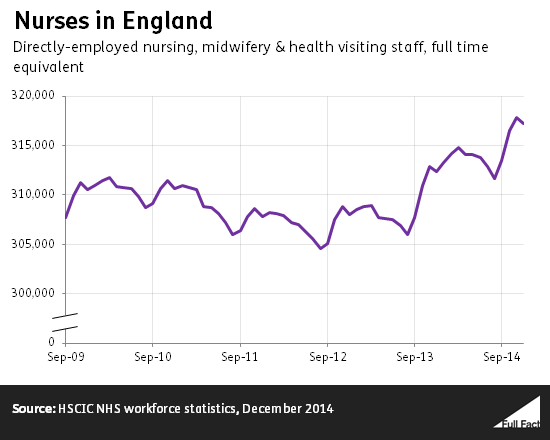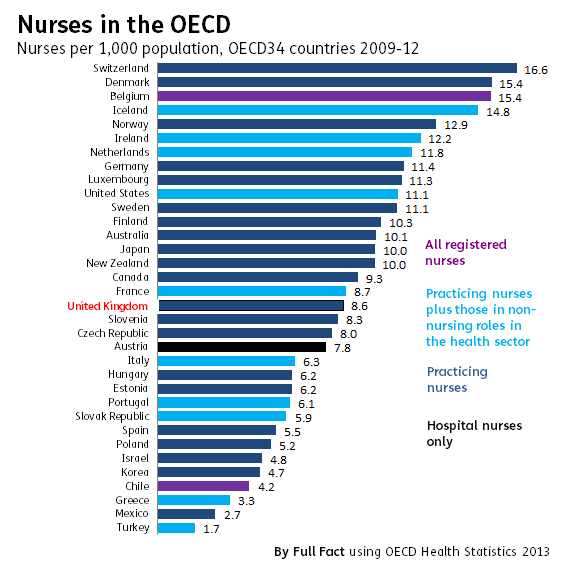Nurses in the UK and abroad
- The effective number of practising nurses generally fluctuates across the year. So a comparison of the number of nurses from one year to another is most meaningful if figures for both are taken from the same point in the respective year.
- Since the last election the number of nursing staff in England has increased, while in Wales it is broadly similar. In Scotland the level was slightly lower in September 2013 than in September 2010 but is on an upward trend.
- England has fewer effective nursing staff per person than the three other countries of the UK, according to research by the Nuffield Trust and Health Foundation. Differences in who is counted as a nurse mean the numbers are not fully comparable.
- The number of practising nurses per capita in the UK is below the average for OECD countries. But again, the numbers are not fully comparable due to international differences in how staff are counted and which of them count as nurses.
Nursing staff — measures of staffing
Data on the number of directly-employed staff is published by the NHS in each country region of the UK. Agency staff and trainees are not included.
There are two measures of the number of nursing staff; the 'headcount' — the number of individual nurses - and the 'full-time equivalent' (FTE). The latter, which is also known as 'whole-time equivalent' in some regions, is the measure we've chosen to use for the UK statistics as it adjusts the number of employees for the hours they work and therefore is a better indicator of the "effective" number of nurses on duty at any given time.
Of course, the number of directly-employed nurses and midwives doesn't on its own tell us whether or not there are 'enough' nurses. The number of patients, their needs, and the skills mix of nurses also play a key part in this and are outside the scope of this guide.
Join 72,953 people who trust us to check the facts
Sign up to get weekly updates on politics, immigration, health and more.
Subscribe to weekly email newsletters from Full Fact for updates on politics, immigration, health and more. Our fact checks are free to read but not to produce, so you will also get occasional emails about fundraising and other ways you can help. You can unsubscribe at any time. For more information about how we use your data see our Privacy Policy.
The number of directly employed nursing staff in England, Scotland, Wales and Northern Ireland
England had 5.8 nurses (including midwives and health visitors) per 1,000 of the population in 2011 according to analysis by the Nuffield Trust and Health Foundation. For Scotland, the figure was 7.9, for Northern Ireland it was 7.5, and for Wales it was 7.1.
But as the research noted, the health services of England, Scotland, Wales and Northern Ireland count different types of workers as nursing staff. This means the figures are not fully comparable.
For England, staff numbers are published by the Health and Social Care Information Centre.
Trainee nurses tend to qualify in November, meaning numbers are highest at that time of year. The variation in numbers is especially visible in the English data because numbers for every month are published.
In Scotland the figures are broken down by quarter. The numbers fell from about 58,000 in September 2010 to 56,000 in September 2012, but have since risen past 59,000.
In Wales, they're published annually. Numbers have stayed fairly consistent at about 28,000 in each year from 2008 to 2013.
In Northern Ireland qualified nurse and midwife numbers dipped slightly from 13,900 in 2010 to 13,600 in 2011, before rising to 14,400 by 2014.
Nurses in the OECD: not all nurses are counted equal
The OECD publishes data on the number of practising nurses per capita in each of its members. This is based on the headcount measure of staff numbers.
The way nurses are counted differs across countries, which has a big effect on its comparability. For instance, Belgium counts all registered nurses rather than the number who are practising, resulting in what the OECD calls "a large over-estimation" of the number of nurses in the country. A number of other countries count nurses who are in non-practising roles in the health sector, for instance those who have become managers.
There are other comparability issues which aren't broken down in our chart:
- Different countries have different ideas of what counts as a nurse; for example the OECD says only half of the countries count midwives.
- Some countries count agency nurses and some don't.
- Because it's a headcount measure it doesn't take into account the hours worked.
And there are questions over how much this information can tell us about the quality of healthcare; nurses have different roles in different systems according to the traditions of the country in question.

